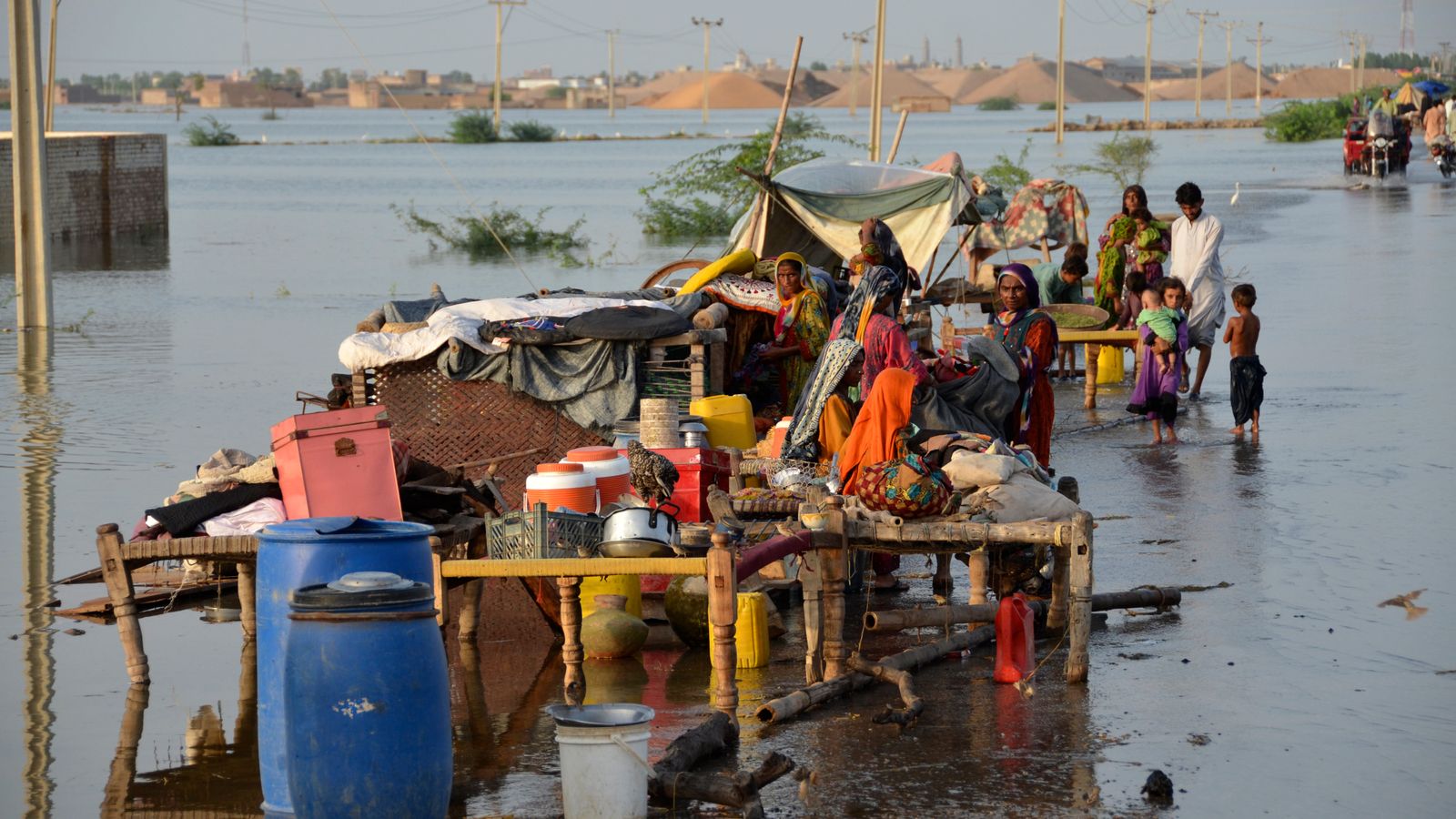This year’s flooding in Pakistan has killed more than 1,000 people and displaced 33 million.
Sherry Rehman, the country’s top climate official, has warned Pakistan is “at the ground zero” of “flash foods, multiple glacial lake outbursts, heatwaves and now the monster monsoon of the decade”.
Since monsoon season started earlier than usual in June, a third of the country has disappeared underwater, with whole villages washed away, crops ruined and people desperately seeking higher ground.
Meanwhile, Pakistani officials have been calling on the UN and the international community for aid.
Here Sky News looks at why Pakistan is on the frontline of the climate crisis – and whether it can withstand the increasingly extreme weather yet to come.
Please use Chrome browser for a more accessible video player
More glaciers than anywhere outside the Arctic and Antarctic
Pakistan is home to around 221 million people.
The majority of the population live along the Indus River, which flows from the Himalayas, through most of the country down to the Arabian Sea at Karachi.
During monsoon season in July and August, the Indus is prone to flooding – something that has been accelerated by climate change.
In the northern Himalayan regions, Pakistan is home to more glaciers than anywhere else in the world outside the Arctic and Antarctic – some 7,000 in total.
Rising global temperatures, which reached almost 50C (122F) in the city of Nawabshah earlier this year, are causing those glaciers to melt and form glacial lakes.
Around 3,000 new lakes have formed, with officials warning 33 of them are currently at risk of bursting.
Many already have so far this year.
When the Shisper glacier burst in May, it released millions of cubic metres of water, causing landslides and creating a lake that destroyed a bridge, two power plants and hundreds of homes in the Hunza Valley.
Please use Chrome browser for a more accessible video player
‘Monster monsoon’
While the Indus flows fuller and faster than usual from the north of the country, the southern provinces of Sindh and Balochistan are suffering unprecedented levels of rainfall.
Sindh in the southeast has had 784% of its normal rainfall levels this year, while Balochistan in the southwest has had 522%.
The mountain region of Khyber Pakhtunkhwa in the north has also been hit badly by the same “monster monsoon”, with none of Pakistan’s four provinces escaping unaffected.
Usually the active rainfall season only lasts for a month-and-a-half in July and August, but this year, it started early and is not showing any signs of slowing.
Climate minister Sherry Rehman said recently on Twitter: “Pakistan has never seen an unbroken cycle of monsoon like this.
“Eight weeks of non-stop torrents have left huge swathes of the country underwater. This is no normal season. This is a deluge from all sides, impacting 33 million people, which is the size of a small country.”
Can Pakistan cope on the frontline of climate change?
Pakistan is the eighth-most vulnerable country in the world to extreme weather, according to the Global Climate Risk Index compiled by NGO Germanwatch.
This summer’s flooding has impacted 15% of the total population, leaving roads, bridges and key infrastructure underwater, communities cut off and people without food or resources.
The government declared a state of emergency on 25 August, but with dry land sparse, airlifting supplies to the displaced is proving difficult for the military and aid organisations.
The UN has allocated £2.6m for its agencies and their partners to help respond to the floods, with the UK adding £1.5m in urgent support, alongside pledges from the US and UAE.
Rebuilding could take years
But Pakistani military chief General Javed Bajwa warned on Sunday that it could take years for the country to recover.
And many Pakistanis and climate change campaigners have blamed the government for ignoring the urgency of the crisis and not building enough preventive infrastructure.
Political instability and the recent ousting of former prime minister Imran Khan, some argue, has also seen climate change pushed further down the agenda.
Despite being deadly, Pakistan’s newly-formed glacial lakes have become tourist attractions, with the authorities criticised for allowing developers to build hotels nearby – and on the banks of swollen rivers – in areas at extreme risk of flooding.
The UN Development Programme has also singled out Pakistan for failing to provide up-to-date information on glacial changes, making potential disasters difficult to predict.
And with more rain expected in September, climate change minister Ms Rehman told Sky News: “There’s absolutely no capacity left to absorb any more water.”
In the longer-term, a 2019 study by the Nepal-based International Centre for Integrated Mountain Development predicts that even achieving the 1.5C limit on global warming by 2050 would mean a third of Pakistan’s glaciers melting.
Ms Rehman said the current crisis will “cause a series of long and medium-term repercussions” and mean a huge reconstruction effort.
Dr Asif Khan Khattak, an environmental scientist at the University of Peshawar, added: “We will be seeing more extreme weather events.
“It’s very important that we take into account climate change planning in our regulations, our policies.
“If we don’t have that, we will experience the same problems in the future.”
Read more:
Pictures reveal devastating impact of Pakistan’s floods
Queen and PM send messages to Pakistan
There has been some external investment already.
In the mountainous Gilgit-Baltistan and Khyber Pakhtunkhwa regions, the UN’s Green Climate Fund has funded better early warning systems, 50 weather stations across 24 valleys, slope stabilisations and better irrigation systems.
It claims this will benefit up to 700,000 people directly and 29 million indirectly.








